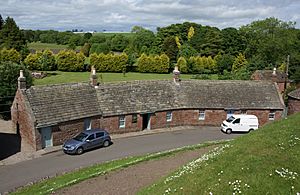St Vigeans Sculptured Stones Museum facts for kids
The St Vigeans Sculptured Stones Museum is a super cool place in the village of St Vigeans, Scotland. It holds an amazing collection of ancient Pictish carved stones. These stones tell stories from a long, long time ago!
St Vigeans is very close to Arbroath. It was a really important place in the Early Middle Ages. It was once a royal estate, which means it was a special area owned by a king or queen. It also had a very important monastery, a place where monks lived and prayed, which was started in the 8th century. The church you see there today, St Vigeans Church, was built in the 12th century on a mound about 40-foot (12 m) high.
Contents
What Are Pictish Stones?
Discovering Ancient Art
The museum shows off 38 carved stones. These stones used to stand on the old church mound. They are special because they were made by the Picts. The Picts were an ancient group of people who lived in eastern and northern Scotland during the Late Iron Age and Early Medieval periods. They were known for their unique art and symbols.
The Drosten Stone: A Special Find
One of the most famous stones in the museum is the Drosten Stone. This stone was carved in the 9th century. It's a flat, rectangular slab. On one side, it has a cross carved into it. On the other side, you can see mysterious Pictish symbols. What makes it even more special is that it has an inscription, or writing, in the Pictish language. This writing uses Latin script, which is the same type of alphabet we use today.
Visiting the Museum
Where to Find It
The St Vigeans Sculptured Stones Museum is managed by Historic Scotland. This is an organization that looks after many historic sites in Scotland. The museum is located in two old sandstone cottages. These cottages are right next to the church. They were built in the 19th century and are considered a "category B listed building." This means they are important historical buildings that need to be protected.
Why Visit?
Visiting the museum is like taking a step back in time. You can see the incredible artwork of the Picts up close. It's a great way to learn about the history of Scotland and the people who lived there centuries ago. The stones give us clues about their beliefs, their art, and their way of life.



